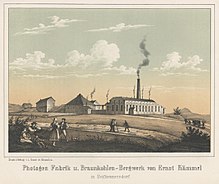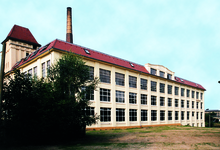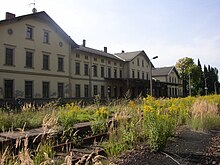Seifhennersdorf
| coat of arms | Germany map | |
|---|---|---|

|
Coordinates: 50 ° 56 ' N , 14 ° 37' E |
|
| Basic data | ||
| State : | Saxony | |
| County : | Goerlitz | |
| Height : | 360 m above sea level NHN | |
| Area : | 19.12 km 2 | |
| Residents: | 3660 (Dec. 31, 2019) | |
| Population density : | 191 inhabitants per km 2 | |
| Postal code : | 02782 | |
| Area code : | 03586 | |
| License plate : | GR, LÖB, NOL, NY, WSW, ZI | |
| Community key : | 14 6 26 530 | |
| LOCODE : | DE YSF | |
City administration address : |
Rathausplatz 01 02782 Seifhennersdorf |
|
| Website : | ||
| Mayoress : | Karin Berndt ( UBS ) | |
| Location of the town of Seifhennersdorf in the district of Görlitz | ||
Seifhennersdorf ( Upper Sorbian Wodowe Hendrichecy ) is a Saxon country town in the district of Görlitz . It is located in the southeast of Saxony in the valleys of the Mandau and Leutersdorfer water , right on the border with the Czech Republic .
Locations
In addition to Niederhennersdorf, which extends along the Mandau, the Soap and Disk settlements in the Leutersdorfer Wasser valley have grown together into one place, as have the Läuterau houses below the confluence of the stream in the Mandau valley. The village of Halbendorf is located directly on the Bohemian border near Varnsdorf (German Warnsdorf ).
history
The place Seifhennersdorf came into being after 1250 and was probably founded by farmers from Main Franconia as a Waldhufendorf . The village, first mentioned in 1352, which was called "Henrych", "Heinrichstorph" or "Henricivilla" in the 14th century, was part of the Tollenstein rule . In 1584 the Niederdorf ("Niederhennersdorf together with the Seiffen") was bought up by the city council of Zittau for 16,000 thalers and 100 Hungarian guilders, while the upper village ("Oberhennersdorf", today Horní Jindřichov ) remained in the possession of the Tollensteiners. The pure farming village developed into a weaving village. Smaller settlements of Bohemian exiles have sprung up in the area since the 17th century . The current place name Seifhennersdorf was created between 1780 and 1800. In the north-east of the town was the “ Great Pond ”, in which the Leutersdorf water was dammed up until it broke in 1803.
The typical half-timbered houses were built especially from the middle of the 18th century, some of which are now listed .
Between 1796 and 1798 a new church was built in place of the old village church according to plans by the builder Carl Christian Eschke . The cruciform church , built in the classicist style, offered space for 2450 people, the church hall was surrounded by three circumferential galleries.
In the second half of the 19th century, well-known weaving mills, the clothing factories and the "large tailoring", the machine factory, the wooden shoe and slipper factory as well as other branches of industry emerged. In the middle of the 19th century, smaller brown coal deposits were developed. In addition to the “Black Coal Works on the Big Pond” there was the “Unity Mine” in the Läuterau and the “Holy Trinity Mine” near Halbendorf. The latter both were operated by the merchants Gebr. Wehnert from Warnsdorf . At the end of the 19th century, the quarrying of polishing slate began on Richterberg . In 1874 Seifhennersdorf received a railway connection to Eibau , the line to Zittau was not closed until 1876.
The construction of the factories mentioned, the train station, the 190 m long viaduct, new schools and roads as well as the gas and waterworks changed the townscape noticeably after 1870. In 1900 there were 78 farms in Seifhennersdorf. In 1903 coal mining was finally stopped.
In 1911 the Leipzig pianoforte factory Gebr. Zimmermann AG built a branch in Seifhennersdorf, which was taken over in 1992 by the C. Bechstein pianoforte factory . Bechstein has relocated its German production there.
In 1925 a new town hall was built in the vicinity of the Kreuzkirche . On the night of March 22nd to 23rd, 1935, the Kreuzkirche burned down. The reconstruction was completed in 1936. Richard Schiffner from Zittau redesigned the interior of the church in place of the destroyed interior .
During the Second World War , Seifhennersdorf was largely spared from fighting and the associated destruction. From January 1944 to March 16, 1945 there was a subcamp of the Flossenbürg concentration camp in the village , whose 30 prisoners had to do forced labor for the Waffen SS . At the end of the war on May 8, 1945, the Soviet armed forces were in the Neugersdorf Forest and were able to occupy the place without a fight the following day.
In 1950, near the forest pool Silberteich the Central pioneer camp " Rosa Luxembourg ", today KiEZ "Querxenland" built. In 1956, the sequence including half of the large pond was reorganized to Leutersdorf.
In 1974 Seifhennersdorf received city rights. On August 30, 2009, the city's residents rejected the establishment of a city of Oberland planned for 2011 as a merger with Neugersdorf and Ebersbach / Sa. with a majority of 65%.
Since the fall of the Berlin Wall (end of 1989), the town has lost around 40 percent of its inhabitants. A clothing and shoe factory ceased production; The largest employer (as of 2012) is the C. Bechstein Pianofortefabrik , a piano maker. The former Kretscham was demolished in 2011.
Place name forms
- Seifhennersdorf:
1352: Henrici villa apud Romberch, 1358: Heinrichstorf, 1384: Henricivilla prope Romberg, 1402: im Seiffen, in the Seyffen zu Heinrichsdorff, 1447: Heynerstorff am Seyffe, 1483: Hennersdorff im Seiffenn, 1584: Niederhennersdorf together with the Seiffen, 1657 : Hennersdorf in Seiffen, 1836: Seifhennersdorf - District Halbendorf:
1566: Klein Hennerßdorf, 1696: Halbendorf, 1719: half the village, 1805: the Halbedorf, 1899: Halbendorf
Administrative affiliation
1777: Bautzen district, 1843: Löbau district court, 1856: Großschönau district court, 1952: Zittau district, 1994: Löbau-Zittau district, 2008: Görlitz district
Population development
In 1777 there were 71 possessed men , 124 gardeners , 309 cottagers . The following figures are available for later years:
|
|
politics
City council
The last six elections each produced the following results:
| Political party | 1994 | 1999 | 2004 | 2009 | 2014 * | 2019 | |||||||
|---|---|---|---|---|---|---|---|---|---|---|---|---|---|
| % | Seats | % | Seats | % | Seats | % | Seats | % | Seats | % | Seats | ||
| CDU | 42.5 | 7th | 46.2 | 8th | 33.3 | 5 | 23.9 | 3 | 44.3 | 7th | 34.7 | 5 | |
| PDS / Left | 11.9 | 2 | 15.1 | 2 | 14.3 | 2 | 13.0 | 2 | 25.3 | 3 | 7.2 | 1 | |
| SPD | 6.3 | 1 | 10.3 | 2 | 7.2 | 1 | |||||||
| FDP | 8.2 | 1 | 4.1 | 0 | |||||||||
| UBS | 31.1 | 5 | 24.4 | 4th | 45.1 | 6th | 63.1 | 9 | 30.4 | 4th | 52.2 | 8th | |
| SGS | - | - | - | - | - | - | - | - | - | - | 5.8 | 0 | |
* The local elections on May 25, 2014 resulted in the following distribution of the 14 seats in the city council: UBS : 5 seats, CDU : 6 seats and LEFT : 3 seats. The election of May 25, 2014 was declared invalid by the District Office. The election carried out on November 9, 2014 finally resulted in the following distribution of seats: UBS 4 seats, CDU 7 seats and LEFT 3 seats.
mayor
- 1994 - 1998: Norbert Pientka (independent)
- 1998 - 2001: Christoph Lommatzsch (CDU)
- since 2002: Karin Berndt (UBS), re-elected in 2009 and 2016
coat of arms
The heraldic eagle at the top right indicates that Seifhennersdorf was part of Zittau. The scales at the top left are a symbol of justice. The spindle at the bottom right attests to the local textile industry and the oak sticks at the bottom left are a reminder of the former Bohemian landlord Hronovice . The S in the center stands for the place name.
Partner communities
-
 Świeradów-Zdrój , Poland
Świeradów-Zdrój , Poland -
 Gaimersheim , Bavaria
Gaimersheim , Bavaria -
 Udvari , Hungary
Udvari , Hungary -
 Ünye , Turkey
Ünye , Turkey
traffic
Seifhennersdorf has a train station on the Mittelherwigsdorf – Varnsdorf – Eibau line . The train service to Eibau was stopped in 2006. Today the Seifhennersdorf station forms the end of the international passenger trains from Liberec, Zittau and Varnsdorf. In 2011, a replacement train stop was built in front of the level crossing from the direction of Varnsdorf, as the trains were no longer allowed to enter the Seifhennersdorf train station due to the dismantling of the barrier system in Nordstrasse. With the construction of this replacement stop, the replacement rail traffic between Varnsdorf and Seifhennersdorf could be ended. However, since March 2015 there have been no more trains, all trains end at the last train stop before the infrastructure border (Varnsdorf pivovar Kocour). Instead of the train, a minibus with limited capacity shuttles between this stop and Seifhennersdorf.
The KVG Dreiländereck has bus connections to Eibau , Neugersdorf , Zittau and Olbersdorf , while the Czech company Autobusy Karlovy Vary operates line 409 (DÚK) Varnsdorf – Seifhennersdorf – Rumburk– Velký Šenov / Dolní Poustevna .
There are also two border crossings to the neighboring towns of Rumburk (Rumburg) and Varnsdorf (Warnsdorf) .
Culture and sights
Seifhennersdorf has many half-timbered houses.
On the 429 m high Burgsberg (Hrádek) directly behind the border in Warnsdorf , the architect Möller built a luxurious excursion restaurant in 1904. This striking object on the local mountain of Seifhennersdorf and Warnsdorf fell into disrepair after 1945. In the last few years, a cross-border association has carried out a renovation of the building, which has decayed into ruins and which has already been restored to a large extent in its old beauty.
In the urban area, next to the children's recreation center “ KiEZ Querxenland”, there is the “Silberteich” forest and adventure pool .
Museums
The Karasek Museum is located next to the town hall and is known for an originally furnished Upper Lusatian Heimatstube as well as the depiction of the robber and smugglers' nuisance at the end of the 18th century with special mention of the robber captain Johannes Karasek .
The Frey family's private railway museum on Arno-Förster-Strasse opened on June 9, 2001. In addition to an H0 model railroad layout with an area of 22 m², the master butcher Frey's exhibition also includes other model railways and tin toys.
The Büttrich family's doll collection can be viewed in the village of Läuterau. The doll museum houses the largest collection of dolls in Saxony with 1700 copies. Dolls, teddies and 30 dollhouses can be seen on an exhibition area of 90 m².
The "Microscope", housed in the rooms of the Bulnheimschen Hof not far from the Karasek Museum, is not just a museum, but one designed by the geologist Dr. Andreas Braun-run facility for journalism on geology and microscopy. In addition to journalistic projects, school classes, children’s and holiday groups are actively introduced to the geology of the region, microscopy and microphotography.
Memorials
A memorial stone from 1949 in front of the town hall commemorates all victims of fascism and war and violence. Two memorial stones in Seifhennersdorf, in the children's recreation center and in the natural healing park, remember Ernst Thälmann .
Companies
Seifhennersdorf is the location of the former VEB Bekleidungswerke Seifhennersdorf for parachutes (before that, Henking company since 1938), today Spekon Sächsische Spezialkonfektion.
In the course of the reorganization of the Bechstein Group, the former Zimmermann piano factory became the first production site of the Berlin-based group. Since then, Bechstein has been manufacturing C.Bechstein Concert and C.Bechstein Academy pianos and grand pianos at the Seifhennersdorf site with around 280 employees (as of summer 2020).
education
Seifhennersdorf has a primary school, the Oberland-Gymnasium and a secondary school, for the continuation of which a legal dispute has been conducted for years. The unauthorized continuation of school lessons in 2012 by some parents, who were often referred to as "school rebels", became known nationwide. Since 2015, new fifth classes have been regularly formed.
Personalities
Sons and daughters of the church
- Gottfried Grünewald (around 1673–1739), singer, harpsichordist and composer
- Johann Gottfried Häntzschel (1707–1748), Protestant theologian
- Rudolph Berndt (1838–1919), Director of the Chemnitz State Technical College, the predecessor of the Chemnitz University of Technology
- Bernhard Neumann (1867–1953), chemist
- Rudolf Otto Neumann (1868–1952), hygienist and bacteriologist
- Bruno Paul (1874–1968), architect, caricaturist in the Simplicissimus , art nouveau artist
- Anna Strohsahl (1885–1953), politician (SPD), the only female councilor in the Cuxhaven city parliament
- Otto Jentsch (1898–1978), engineer and from 1952 to 1956 rector of the Dresden University of Transport
- Johannes Cieslak (1914–2003), stove fitter and president of the regional synod
- Rainer Roscher (1924–2017), choirmaster and organist
- Peter Mertens (* 1937), business IT specialist
- Volkmar Böhm (1938–2007), pop singer and event organizer
- Jürgen Cieslak (* 1942), stove setter and preservationist
- Volker Bednara (* 1945), Colonel of the National People's Army of the GDR
- Wolfgang Häntsch (* 1951), actor, radio play and voice actor
- Marie-Luise Lichtenthal (* 1959), stage and costume designer
- Rica Reinisch (* 1965), swimmer, 1980 Olympic champion in Moscow
- Silke Grimm (* 1967), politician (AfD), member of the state parliament and entrepreneur
Honorary citizen
- 2000 Max-Heinz Farke (1913–2003), Protestant pastor
- 2001 Senol Yegin, Turkish entrepreneur, SPEKON company
- 2008 Herbert Vogt, painter
See also
- Frenzelsberg
- WOOLING.NET , school and online magazine from Seifhennersdorf
literature
- Cornelius Gurlitt : Seifhennersdorf. In: Descriptive representation of the older architectural and art monuments of the Kingdom of Saxony. 29. Issue: Amtshauptmannschaft Zittau (Land) . CC Meinhold, Dresden 1906, p. 226.
- Otto Moritz Kind: History of Seifhennersdorf . Seifhennersdorf 1892 ( digitized version )
- August Friedrich Richter: Some news from Seifhennersdorf in Upper Lusatia. Müller, Seifhennersdorf 1802 ( digitized version )
Web links
Individual evidence
- ↑ Population of the Free State of Saxony by municipalities on December 31, 2019 ( help on this ).
- ↑ a b Seifhennersdorf in the Digital Historical Directory of Saxony
- ↑ seifhennersdorf.de ( Memento of the original from January 3, 2010 in the Internet Archive ) Info: The archive link was inserted automatically and has not yet been checked. Please check the original and archive link according to the instructions and then remove this notice.
- ↑ [1] , website of the Flossenbürg Concentration Camp Memorial. Retrieved July 6, 2016
- ↑ Silberteich forest pool. In: The south-eastern Upper Lusatia with Zittau and the Zittau Mountains (= values of the German homeland . Volume 16). 1st edition. Akademie Verlag, Berlin 1970, p. 64.
- ↑ Piano instead of forte . FAZ.net
- ↑ www.wahlen.sachsen.de: Results of the municipal council election 2019 - Seifhennersdorf
- ↑ www.wahlen.sachsen.de: Results of the municipal council election 2019 - Seifhennersdorf
- ^ Results of the 2014 municipal council elections in Seifhennersdorf. State Statistical Office of the Free State of Saxony , accessed on May 28, 2014 .
- ↑ Landratsamt Görlitz declares city council elections in Seifhennersdorf to be invalid .
- ↑ Seifhennersdorf Official Gazette , November 12, 2014
- ↑ http://www.sz-online.de/nachrichten/seifhennersdorf-behaelt-seine-buergermeisterin-3473317.html
- ↑ http://www.spekon.de/ today Sächsische Spezialkonfektion GmbH
- ↑ Frauke Lüpke-Narberhaus: School deaths in Saxony: The fighting classroom . In: Spiegel Online . June 10, 2013 ( spiegel.de [accessed October 4, 2017]).
- ↑ mdr.de: School start: Oberschule in Seifhennersdorf is growing | MDR.DE . ( mdr.de [accessed October 4, 2017]).
- ↑ The Boss from the Bosporus . In: Berliner Zeitung , October 30, 2001.











